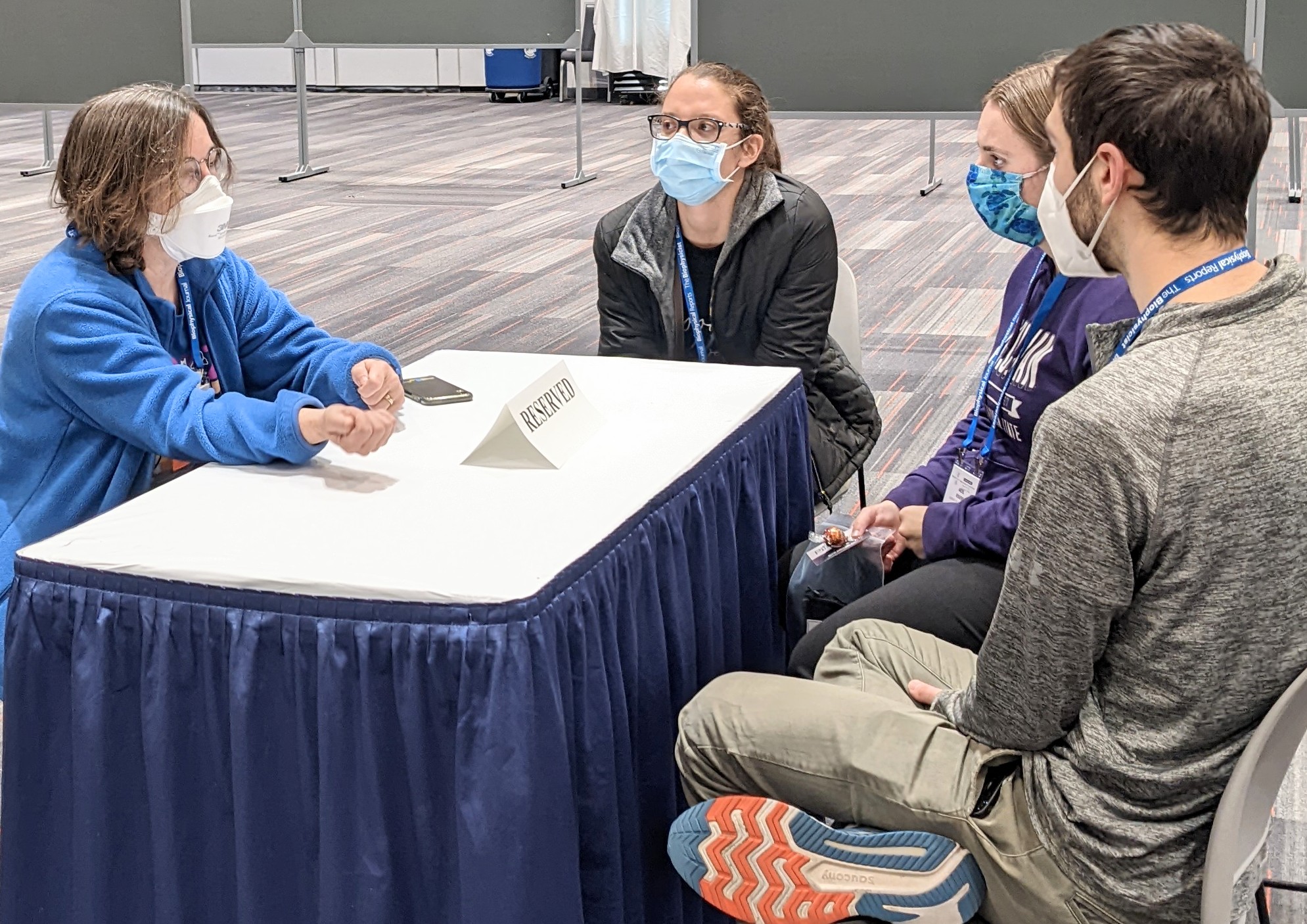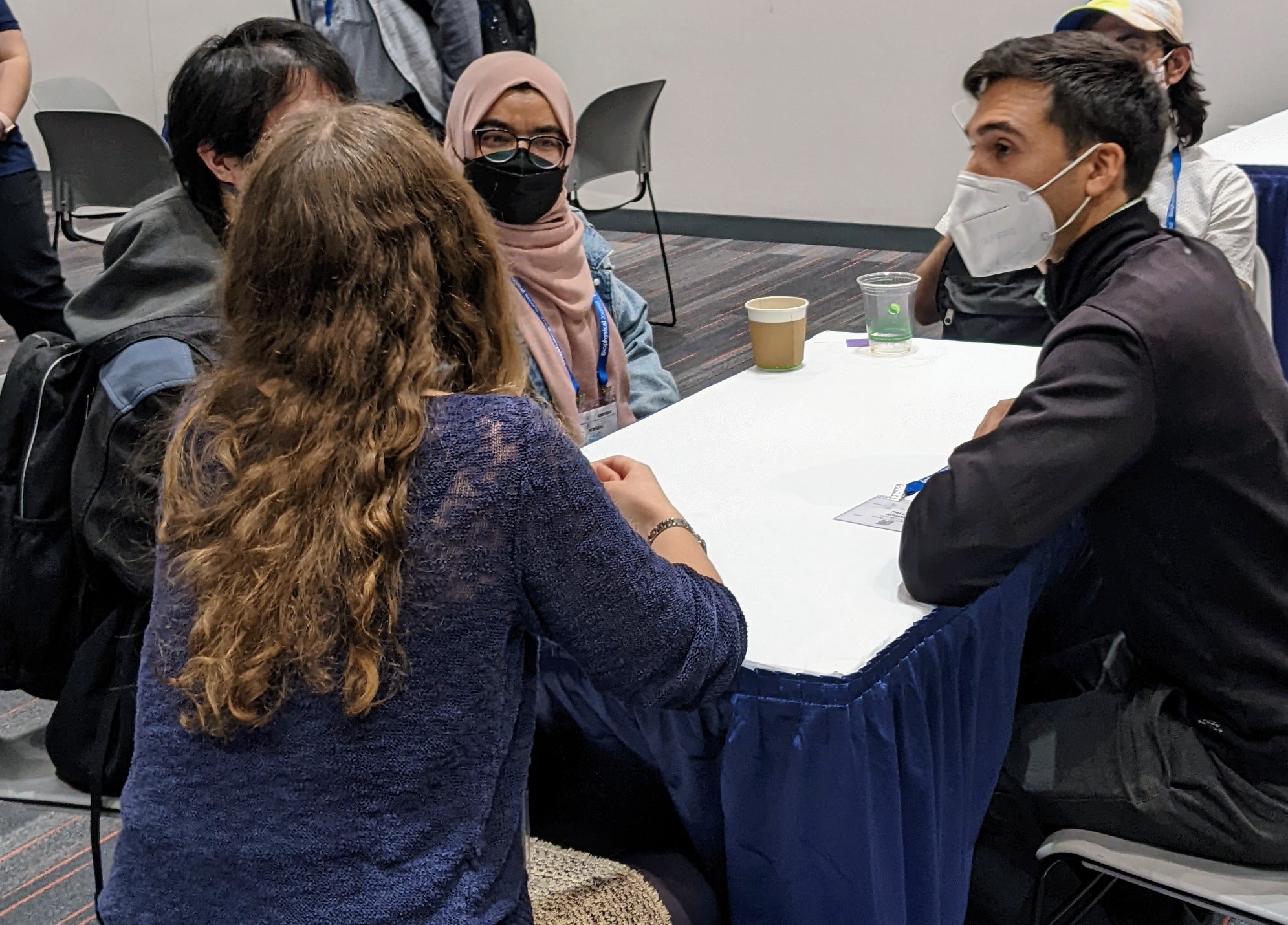I first joined a speed networking event at a Neutrons in Food meeting in Sydney, Australia. We had two rows of chairs: one line of researchers and engineers from industrial R&D facing another with neutron scientists. Think Iron Man and you’ll get a feeling for the intensity of the race. As the clock ticked away, we fought an impossible battle against time to explain what neutrons can for a healthier, sustainable nutritional future. In the end, nobody reached the finishing line, yet we all won. As I left the BPS2022 Speed Networking event, I thought we were all championing a better future as well.
I registered hoping to connect with random biophysicists, in the same spirit that I browse random boards at the poster sessions: to think outside my box and grow a broader perspective. Not just about the Science, but – arguably more important – about the people who push it forward. As scientists we have a tremendous responsibility to practice the expression of what we do. An undeniably handy tool when it comes to grant writing and collaborations, but above all a need to communicate the impact of Science. So that when the next big event hits us – a pandemic or even an earthquake in the Bay area – we do not find ourselves talking to a wall of mistrust, or avoiding to look up in case there is a very large comet coming to get us. I suspect the younger generations have understood this better than us more senior or mid-career Biophysicists: take Brandon Malady, a graduate student at the University of Texas, Austin. If I had not attended this networking event, I could probably find out that he was a graduate student at the Stachowiak group, interested in cellular membranes and their biophysical properties. It is however unlikely that I would come across his Goggles Off podcast,where he talks to scientists about their lives and their research, a Science simplified kind of gig. Biophysics does not begin nor end in the laboratory.


I was delighted and slightly scared when Margaret Mainguy (BPS Programs coordinator) asked me to sit on the mentor side of the Speed Networking tables. As a Small Angle Neutron Scattering (SANS) scientist, I do love my contrasts, and I can be just as quiet as a full-on chatterbox, depending on the setting and the subject of the conversation. Sitting on the mentor side, I was happy to talk about what I love about my job and what it is to have a non-conventional career path (if conventional ones even exist anymore). I would also get to hear about fantastic new science, the student enthusiasm and that breath of fresh air that no mask can hold back. On the other hand, having volunteered to many career fairs and STEM events throughout the years, I was well aware of the difficult questions one can get. I make absolutely no claims of knowing the right answer(s) but I think it may be useful to share a couple of them.
I feel I can program just about anything now, but how can I find out where best to put my skills at work? I definitely noticed a strong emphasis on computational-based research at this year’s meeting. Simulations, molecular dynamics and image processing are popular facets of Biophysics that filled up the rooms in the symposia. The dichotomy of in-silico work versus laboratory measurements is old news: as an experimentalist, I am no more allowed to ignore the inner workings of the software I use, than a programmer is able to contribute to impactful science without understanding the underlying research. As someone who benefited tremendously from summer internships and student exchanges in Europe, I can only recommend spending some time in different groups and laboratories to find that environment and trigger that makes us get up and go to work, because we all want to make a difference. Internship and training opportunities announcements are not hard to find but, if you don't see one that fits, there can be no harm in contacting advisors directly and having a chat. From my experience, it is only by working on a project that you truly understand the full scope and how best to put your skills at work.
Have you ever come across a situation where you had to choose between family and work? This is one of those questions along the same lines as ‘Are you happy?’. It can easily throw you into a mid-life crisis (no matter how young you are). My job involves local contacting for students and scientists, who have often invested their all into preparing samples and need data to finish their projects, or answer that pending question that the reviewer will not let go of. Neutron experiments run 24/7, so choosing to be an instrument scientist does involve frequent choices between personal life and work. Often, they will not feel like choices at all, but I try to remind myself that they are. Would it be easier to have a 9-to-5 job? Perhaps, but I would not have the privilege of working with such a breadth of people, cultures and projects. I would not be learning new things every single day, as I use sub-atomic particles to answer questions that are very palpable and macroscopic to me. In the end, fulfilment is a personal experience, it is about asking ourselves if we are happy with what we are doing and be prepared to change if not. There is not one single job for one person, for all eternity: our needs change as much as Biophysics and the world around us.
As I connected with open minded students and younger researchers that came to a Speed Networking event to talk about all sorts of things that matter, in and out of the lab, I was overwhelmed by the questions that remain relevant across generations. We truly are all in this together (make sure you also check out Julia Migliore’s blog on Togetherness, at the BPS blog website). Since I did not get a chance to Speed Network with other mentors, I figure it is only appropriate to end this blog with a question: have you registered to the next Speed Networking event?